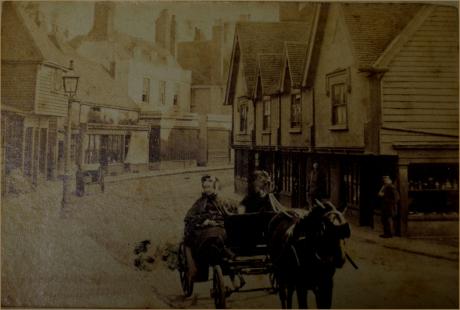Sevenoaks is a town in Kent with a population of 29,506 situated south-east of London, England. Also classified as a civil parish, Sevenoaks is served by a commuter main line railway into London. Sevenoaks is 21 miles (34 km) from Charing Cross, the traditional centre of London. It is the principal town of the Sevenoaks district, followed by Swanley and Edenbridge.
A settlement was recorded in the 13th century, when a market was established. Construction of Knole House in the 15th century helped develop the village. Sevenoaks became part of the modern communications network when one of the early turnpikes was opened in the 18th century; the railway was relatively late in reaching it. In the 21st century, it has a large commuting population, although the nearby Fort Halstead defence installation is a major local employer. Located to the south-east of the town is Knole Park, within which lies Knole House.
There are few records earlier than the 13th century for the town, when it was given market status. The weekly cattle market was held in Hitchen Hatch Lane until 1999. It was closed to make way for the "160 BT building" in London Road. A food market is held in the centre of town every Saturday. In the Middle Ages two hospitals were provided by religious orders for the care of old or sick people, especially those going on pilgrimage.
Sevenoaks School, at the south end of High Street, is one of the oldest lay foundations in England. It was founded by William Sevenoke in 1432. Sevenoke, a foundling, had been brought up in the town. In later life he became a merchant and served as alderman, sheriff and Mayor of London. Founding the school and adjacent almshouses was his thanks to the town. In 1560 the school was granted letters patent by Queen Elizabeth I and became known as 'Queen Elizabeth's Grammar School'. It was "for the education of boys and youths in grammar and learning".
In 1456 Thomas Bourchier, Archbishop of Canterbury, purchased the Knole estate and built Knole House. The mansion dominates the town.
The eponymous oak trees in Knole Park have been replaced several times over the centuries. In 1902 seven oaks were planted on the north side of The Vine cricket ground to commemorate the coronation of King Edward VII. During the Great Storm of 1987, six of those trees were blown down. Their replacements, planted in a ceremony involving well-known people from television shows such as Blue Peter and locals such as Gloria Hunniford and Caron Keating, were vandalised, leaving the one mature tree standing. The trees have been replaced and eight Oak trees of varying ages line The Vine.
A serious railway accident occurred nearby on 24 August 1927. Southern Railway K class passenger tank engine No. A800 River Cray was derailed hauling a Cannon Street to Deal express, knocking a road bridge and killing 13 passengers. The locomotive crew survived. The entire K class was subsequently rebuilt to prevent such an event from occurring again. The accident called into question the quality of track laying in the area.

